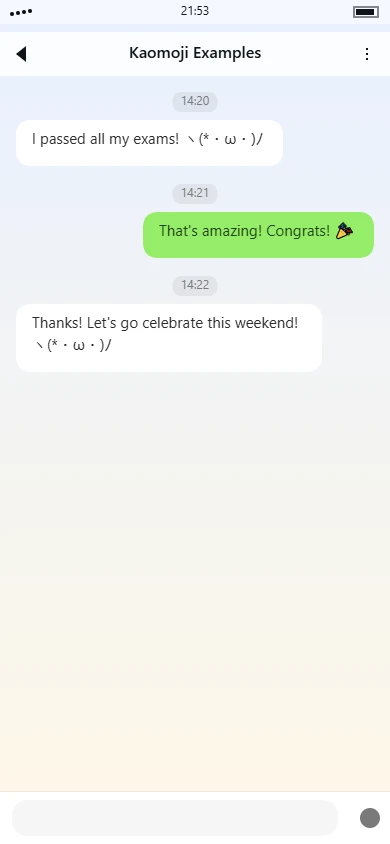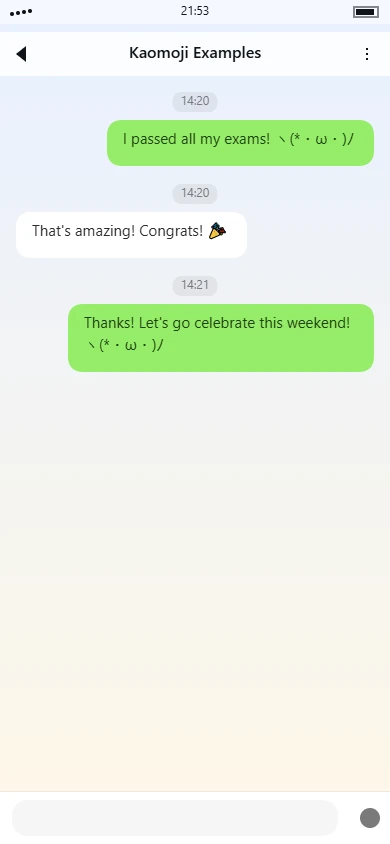(๑˃ᴗ˂)ﻭ kaomoji meaning | usage tips

Overview
The kaomoji
(๑˃ᴗ˂)ﻭVisual Structure Explanation
At first glance, the kaomoji appears as a stylized cat face enclosed within parentheses that serve as the facial outline. The eyes are represented by the Thai numeral characters
๑ᴗﻭSymbol Breakdown
- Parentheses
: These brackets frame the facial features, creating a rounded head shape that contains the expression within a defined boundary( ) - Thai numerals
: Used as eyes, these characters provide a unique rounded appearance with central dots that differ from typical Japanese or Western eye representations๑ - Small capital letter
: This character serves as the mouth, with its upward curve suggesting a gentle smile rather than an exaggerated grinᴗ - Arabic character
: Positioned outside the face, this character resembles a raised appendage, interpreted as either a paw or hand in a waving or greeting gestureﻭ - Comparative spacing: The characters are arranged with slightly tighter spacing between eyes and mouth, while the Arabic character maintains visual separation to distinguish it as a separate element
Emotion & Aesthetic Analysis
The emotional tone conveyed by this kaomoji is one of cheerful contentment with an interactive element. The smiling mouth combined with the rounded eyes creates a generally positive expression, while the raised paw adds a dimension of engagement - as if the character is waving hello or seeking attention. This differs from simpler happy kaomoji that lack the interactive component.
The character selection demonstrates creative cross-script usage, combining Thai, Latin (in the form of small capitals), and Arabic characters to achieve specific visual effects that wouldn't be possible using only one writing system. The Thai numerals provide distinctive eye shapes, while the Arabic character offers a unique solution for representing an appendage. This multi-script approach results in a kaomoji that feels both familiar in its emotional expression and distinctive in its visual construction.
In practical usage, this kaomoji typically appears in casual online conversations to express friendly greeting, cheerful acknowledgment, or playful interaction. It carries a slightly more animated quality than basic smiling faces due to the waving gesture, making it suitable for situations where the sender wants to convey not just happiness but also engagement with the recipient. The feline interpretation adds a layer of cuteness without being overly exaggerated, positioning it in the moderate range of kawaii expression.
Tag categories
Use tags to quickly understand this kaomoji.
Emotion tags
Click tags to explore related kaomoji.
Usage guide
Usage Guide for (๑˃ᴗ˂)ﻭ
This charming kaomoji combines a cheerful face with a waving hand gesture, creating a versatile expression that conveys friendly enthusiasm, playful excitement, and warm acknowledgment. The character features wide, sparkling eyes and a happy smile, accompanied by a waving motion that suggests greeting, celebration, or enthusiastic agreement. It's particularly effective in casual digital communication where you want to express positive emotions with a touch of animated energy.
Common Use Cases
- Celebrating personal achievements or small victories in group chats
- Greeting friends when joining an online gaming session or voice call
- Responding enthusiastically to good news shared in social media comments
- Expressing cheerful agreement with someone's opinion or suggestion
- Adding playful energy to casual conversations with close friends
- Welcoming new members in community servers or group chats
- Reacting to cute pet photos or adorable content shared by friends
- Showing excited anticipation for upcoming events or plans
- Acknowledging compliments or positive feedback with humble enthusiasm
- Lightening the mood during casual work team chats about non-serious matters
- Expressing happy surprise at unexpected but pleasant developments
- Wrapping up conversations on a positive and energetic note
Example Conversations
-
Friend sharing good news Person A: "Just got accepted into my dream university!" Person B: "That's amazing! So proud of you! (๑˃ᴗ˂)ﻭ"
-
Planning weekend activities Person A: "Movie night at my place this Saturday?" Person B: "Absolutely! Count me in! (๑˃ᴗ˂)ﻭ"
-
Online gaming coordination Person A: "Ready for the raid in 5 minutes?" Person B: "All set and excited! (๑˃ᴗ˂)ﻭ Let's do this!"
-
Social media interaction Post: "Finally finished that big project!" Comment: "Congratulations! All that hard work paid off! (๑˃ᴗ˂)ﻭ"
-
Casual work chat Colleague: "The team lunch is confirmed for Friday" You: "Perfect! Looking forward to it (๑˃ᴗ˂)ﻭ"
-
Responding to compliments Friend: "Your new haircut looks really nice!" You: "Aw, thank you! (๑˃ᴗ˂)ﻭ"
Important Considerations
- Avoid using this kaomoji in formal business communications, official emails, or serious discussions where its playful tone might undermine your professionalism
- Be mindful that the enthusiastic waving gesture can sometimes come across as overly excited or childish in more reserved communication contexts
- Consider your relationship with the recipient - this expression works best with friends, close colleagues, or in casual communities rather than with superiors or new acquaintances
- In text-heavy professional environments, this might be perceived as unprofessional or distracting from your main message
- The combination of sparkling eyes and waving motion creates a particularly energetic impression, so use it when you genuinely want to convey high levels of enthusiasm
- Cultural note: This style of kaomoji is most commonly used in East Asian digital communication, but has become widely understood in global online communities through anime, gaming, and social media exposure
Platform Tip: This kaomoji works particularly well on platforms like Discord, Twitter, and casual messaging apps where animated expressions are common. It's less suitable for LinkedIn, formal work emails, or professional networking sites where more restrained communication is expected.
The waving hand element adds a dynamic quality that makes this kaomoji perfect for moments when you want to express not just happiness, but active engagement and cheerful participation. It's like giving a digital high-five while smiling - perfect for building positive connections in your online interactions while maintaining a lighthearted, friendly tone that bridges the gap between text and real emotional expression.
Usage examples
Real conversation samples that feature this kaomoji.

Example 1

Example 2
Related kaomoji
You might also enjoy these kaomoji.